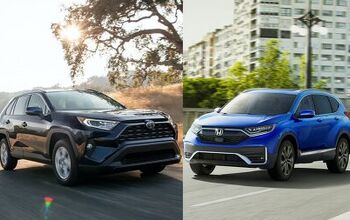2026 Toyota RAV4 VS 2026 Honda CR-V: Which SUV Should You Buy?

The 2026 Toyota RAV4 Hybrid and 2026 Honda CR-V Hybrid continue to dominate the compact SUV segment, appealing to buyers who want reliability, efficiency, and everyday comfort. Both models have earned reputations as top family vehicles, but with new updates to performance, technology, and fuel economy, there’s more separating them than ever.
We spent time behind the wheel of both—the RAV4 Limited Hybrid and the CR-V Touring Hybrid—to find out which is the better all-around buy for 2026.
The AutoGuide Creators Series tells stories and amplifies creators from the car world, including family life, car buying advice, commuting tips, and car culture.
Transcript:
Honda CR-V or Toyota RAV4? Which one should you buy? That’s what we’re going to find out. Welcome to Car Help Corner, where we help you, the consumer, master the process of car buying and ownership. The CR-V and RAV4 are the best-selling crossover SUVs on the market. Now that the CR-V has been updated for 2026 and the RAV4 has been completely redesigned, it’s time to put them back to back and see which SUV you should buy.
First, the basics. The CR-V offers a choice between a regular gas engine on the base trims, or a hybrid drivetrain on most other trims. The standard engine is a 1.5-liter turbocharged four-cylinder on the base LX and Sport models, but most other trims get the hybrid as standard.
Unlike the CR-V, the RAV4 no longer offers a conventional gas engine. You only choose between a hybrid or a plug-in hybrid. To make this a fair comparison, I tested both SUVs with the hybrid drivetrain in top trims: the CR-V Touring and the RAV4 Limited.
Now that both SUVs have been updated, what are they like back to back? Both have excellent hybrid systems and plenty of power. The RAV4 makes 236 horsepower, more than the CR-V’s 204, but the CR-V has more torque at 247 lb-ft. In the real world, both feel strong—there’s ample power for merging, getting up to highway speeds, and everyday driving.
Both hybrids are incredibly smooth; you barely notice the gas engine turning on and off. The tuning shows how well each company understands hybrid design.
Reliability is another common strength. Honda and Toyota have been building hybrids for well over two decades. The CR-V’s hybrid system has been around for over 10 years and is now in its third generation; the RAV4’s has been around longer and is now in its fifth.
Both use simple, naturally aspirated four-cylinder engines—2.0 liters for Honda and 2.5 liters for Toyota—paired with two electric motors and robust, simple transmissions. The Toyota uses an e-CVT planetary gear set; the Honda is also an e-CVT, but it’s essentially a “virtual” e-CVT because it doesn’t use a conventional transmission at all. Either way, both are designed to last a very long time. If you want a reliable hybrid SUV to keep for 10–15 years or more, either one fits the bill.
Here’s a major difference: fuel economy. The main reason to buy a hybrid is to save money on gas, and in that area the RAV4 does better. The new hybrid is rated between 40–45 mpg (5–6 L/100 km), which is significantly better than the CR-V’s 36–42 mpg (about 6–6.5 L/100 km). If you want to save the most on fuel, the RAV4 is the better choice.
Another advantage for the RAV4 is towing capacity. It can tow up to 3,500 lb on every trim except the base—impressive for a hybrid and far more than the CR-V, which is limited to 1,000 lb.
Both are known for reliability, but Toyota includes a longer hybrid battery warranty—10 years versus 8 years for Honda. And when these vehicles are 12–15 years old, a replacement battery is typically cheaper to source for the Toyota, thanks to better availability of used or rebuilt packs. Overall, for hybrid performance, design, and ownership costs, the RAV4 gets the win.
In the past, the CR-V had a clear advantage for comfort and handling—it was smoother, quieter, and better tuned than the previous-generation RAV4. The redesigned 2026 RAV4 has improved a lot: it’s stiffer, stronger, rides more smoothly, and has a quieter hybrid system, bringing it much closer to the CR-V.
Even so, the CR-V still has a slight edge. It feels a bit more comfortable with nicer ride quality and better suspension tuning—an area where Honda excels. Under hard acceleration, the CR-V’s engine is also smoother and quieter, and it mimics gear changes like a traditional transmission, which enhances refinement. The RAV4 can sound a bit coarser when you really push it. Day to day, though, both are satisfying to drive and most owners won’t have major complaints.
Both are very practical with plenty of room in the front and back and sizable cargo areas—excellent choices for families of three to four. The CR-V does offer slightly more interior and cargo space overall, making it the more spacious option. A downside: it does not have a spare tire under the cargo floor. The RAV4 includes a compact spare on all trims, which many buyers will appreciate.
The CR-V’s cabin feels more premium, with nicer fit and finish and better overall build quality. It also has a very user-friendly control layout, with conventional knobs and buttons for climate controls and a simple, responsive infotainment system that includes wireless Apple CarPlay and Android Auto.
The RAV4’s interior feels more utilitarian and relies more on the touchscreen for controls, which can be a bit more frustrating. However, it offers a larger screen with a more modern interface and more available features.
At the top trims (Touring vs. Limited), the RAV4 outclasses the CR-V with features you can’t get on the Honda: ventilated front seats, heated front and rear seats, a choice of regular or panoramic sunroof (trim-dependent), a digital rearview mirror, a head-up display, a larger touchscreen, and a 360-degree surround-view camera.
Both SUVs come with robust active safety suites—Honda Sensing and Toyota Safety Sense 4.0—and both rate very highly for safety.
At the time of recording, Toyota hadn’t released pricing for the 2026 RAV4; expect it to be close to 2025 with a modest increase. In the U.S., pricing between CR-V and RAV4 is fairly close and should remain so for 2026. In Canada, expect a bigger gap, with the CR-V priced a few thousand dollars higher than the RAV4.
The CR-V offers six or seven trims (two or three gas, four hybrid). The RAV4 offers nearly twice as many, most with the hybrid as standard and a few with the plug-in hybrid drivetrain—great for buyers who want something closer to an EV and can charge at home. The RAV4 Plug-in Hybrid is the most powerful version available at 320 hp and can travel around 50 miles (80 km) on electric power when charged.
Both models are built in multiple locations, including the U.S. and Canada, except the RAV4 Plug-in Hybrid, which is built exclusively in Japan.
Both SUVs have excellent resale value thanks to their reputations for being well-made, long-lasting, and reliable. If you want an SUV that holds its value, either is a smart pick.
For years, the CR-V Hybrid was my top recommendation among compact SUVs. It remains an excellent, no-brainer choice for 2026. But Toyota’s improvements to the 2026 RAV4—smoother ride, more power, better tech—make it a closer match, and in some key areas (fuel economy, towing, technology, features, battery warranty) it surpasses the CR-V.
All things considered, the RAV4 Hybrid is the better overall choice—if you can get one. Availability is a challenge in many regions, especially in Canada, where buyers often need to order and wait months. That’s where the CR-V has a major advantage: much better availability, the ability to buy off the lot, and often a better deal.
If you can wait, choose the RAV4 Hybrid. If you need a hybrid SUV now, the CR-V Hybrid is an outstanding alternative.
Let me know which hybrid SUV you’d pick in the comments. If you enjoyed this video, please like and subscribe. If you’re buying a vehicle in Ontario, remember OMVIC is the vehicle sales regulator responsible for enforcing dealership rules—learn more about your consumer protection rights at omvic.ca. For help negotiating a great deal or any other car-buying advice, visit carhelpcanada.com. Thanks for watching, and I’ll see you next time.
Become an AutoGuide insider. Get the latest from the automotive world first by subscribing to our newsletter here.

Shari Prymak is the host of the Car Help Corner YouTube channel and the Executive Director of Car Help Canada (formally known as the Automobile Consumer Coalition). Car Help Canada is a non-profit organization that supports consumers when dealing with the automobile industry. Mr. Prymak holds Bachelor degrees (BSc and BEd) from the University of Toronto and York University respectively. Prymak’s experience as an automobile consultant has helped thousands of consumers with their automobile purchases and many aspects of automobile ownership. Mr. Prymak has also published a number of research reports on consumer protection and the automobile industry. He also lobbies the government on behalf of consumers and is a member of OMVIC's Consumer Advisory Committee, a delegate authority for the Ontario government. Prymak has hosted programs on consumer protection in the motor vehicle industry on social media, television and radio.
































Comments
Join the conversation